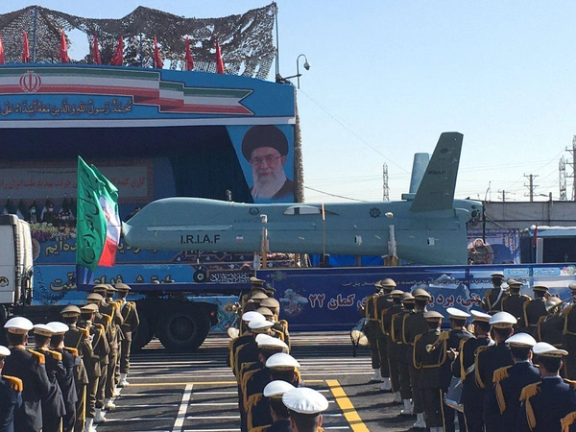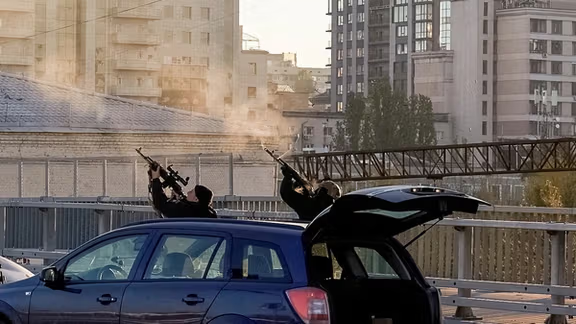Q & A: Snapback, Drones, Missiles And The Iran Nuclear Deal

With the reported use of Iranian drones by Russia, the United States and its European allies face the question of reviving international sanctions by ‘snapback’.

With the reported use of Iranian drones by Russia, the United States and its European allies face the question of reviving international sanctions by ‘snapback’.
What is ‘snapback,’ and why does it matter?
The 2015 Iran nuclear agreement, the JCPOA (Joint Comprehensive Plan of Action), lifted international sanctions against Iran in return for strict limits on the Iranian nuclear program. Under the terms of the JCPOA, the sanctions could ‘snapback’ if Iran violated the agreement.
Is Iran violating the agreement?
Iran began breaching JCPOA limits – for example on the level of uranium enrichment, and with the number and kind of centrifuges in use – in 2019, the year after President Donald Trump withdrew the US from the 2015 agreement and imposed ‘maximum pressure’ sanction.
So why is ‘snapback’ being raised now?
It has come up because France, Germany, the United States and the United Kingdom have told the United Nations that Iran’s reported supply of military drones to Russia for use in Ukraine violates UN Security Council Resolution 2231, by which the council endorsed the JCPOA.
UNSC Resolution 2231 contained a clause that up to October 2023 prior UNSC approval would be needed for the transfer to and from Iran of certain military equipment and weapons. So, the US is arguing that Iran’s supply of drones violates that clause – and this has raised the possibility of snapback, under which multilateral sanctions would come back onto Tehran.
Would the drone supply for sure violate Resolution 2231?
That is yet to be decided. Snapback relates to “significant non-performance of commitments.” Resolution 2231 refers to a 79-page document submitted at the time by the US – S/2015/546 – that listed categories of weapons needing prior UNSC approval. S/2015/546 refers to drones “capable of delivering at least a 50kg payload to a range of at least 300km,” and while Iranian-made Shahed drones can have a range of over 1,000km they carry 40kg of explosives. There would be a clearer violation if Iran transferred Fateh-110 and Zulfiqar missiles, which would meet the criteria.

How would ‘snapback’ work?
Any party to the JCPOA can move snapback. If after 30 days, the issue is not resolved, then UN sanctions would come back into effect. For the issue to be resolved, a UNSC member would need to move that sanctions not come back into play, and this could be vetoed by any other member.
This was the basis for the claims from President Barack Obama and Secretary of State John Kerry at the time the JCPOA was signed that Russia, or China, could not stop snapback. It’s as if the veto power is reversed.
But can the US move ‘snapback’? Didn’t it leave the JCPOA?
When the Trump administration tried to move snapback in 2020, other JCPOA members, including the three European signatories (France, Germany, and the UK) said it couldn’t because it had left the agreement.
But this interpretation has been challenged. Gabriel Noronha, an Iran advisor 2019-21 in the Trump administration, argued in tweets this week that the US could move snapback. Noronha’s tweets cited Obama, Kerry, and then vice-president Biden.
What would be the practical effect of snapback?
Some say the ‘bark’ would be worse than the ‘bite.’ For Europe to reimpose sanctions on Iran would make little difference given its trade has massively decreased under US ‘maximum pressure,’ under which any third party can be sanctioned by the US for any Iran dealings. Iran is already unable to access significant funds frozen around the world. Russia and China might just argue that the US undermined the JCPOA and is in no position to cite it as a justification for any actions.
What are US intentions?
In a press briefing Tuesday, State Department Spokesman Ned Price was unenthusiastic over snapback, although his references to a possible Russian veto were speedily rebutted by Noronha. Price referred to other means of restricting Iran-Russia links, including recent US sanctions on Iranian defense companies and generals.
It may be Washington is not so concerned over Iranian-made drones – which are useful to Russia but less effective in the conflict than the publicity might suggest – and that its greater worry is the possible transfer of missiles. US strategy, as explained by Price, is to run down Russia’s military capacities, in the hope either of Moscow’s defeat or a negotiated settlement. In October US, France, Germany and the UK wrote a letter to the UN secretariat asking for an investigation of the alleged Iranian drone supply – and that’s where things stand at present.
How is the Ukraine war impinging on talks to revive the JCPOA?
Another reason for the US not moving snapback might be the logic, inherent in the JCPOA, that the nuclear file can be kept largely separate from other issues. Given critics of the agreement argue such separation is difficult, if not impossible, the Biden administration is saying it can take stringent measures against Iran – over missiles, or treatment of protests – while continuing its efforts to revive the JCPOA. Only time will tell if they are right.